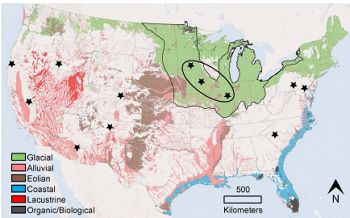Anders et al., 2018
Impacts of Quaternary History on Critical Zone Structure and Processes: Examples and a Conceptual Model from the Intensively Managed Landscapes Critical Zone Observatory
Anders, A.M., Bettis, E.A., Grimley, D.A., Stumpf, A.J., and Kumar, P. (2018)
Frontiers in Earth Science
-
IML, INVESTIGATOR
-
IML, INVESTIGATOR
-
IML, INVESTIGATOR
-
IML, INVESTIGATOR
-
IML, INVESTIGATOR
Abstract
Generalized map showing surficial materials (Source of data: U.S Geological Survey, Soller et al., 2009) and the locations of CZO field observatories within the conterminous United States.
The concept of a critical zone (CZ) supporting terrestrial life has fostered groundbreaking interdisciplinary science addressing complex interactions among water, soil, rock, air, and life near Earth’s surface. Pioneering work has focused on the CZ in areas with residual soils and steady-state or erosional topography. CZ evolution in these areas is conceptualized as progressive weathering of local bedrock (e.g., in the flow-through reactor model). However, this model is not applicable to areas in which weathering profiles form in transported materials including the formerly glaciated portion of the Central Lowland of North America. We present a new conceptual model of CZ evolution in landscapes impacted by continental glaciation based on investigations at three study sites in the Intensively Managed Landscapes Critical Zone Observatory (IML-CZO) The IML-CZO is devoted to the study of CZ processes in a region characterized by thick surficial deposits resulting from multiple continental glaciations, with bedrock at depths of up to 150m. Here the physical (glacial ice, loess, developing soil profiles) and
biological (microbes, tundra, forest, prairie) components of the CZ vary significantly in time. Moreover, the spatial relationships between mineral components of the CZ record a history of glacial-interglacial cycles and landscape evolution.We present cross-sections from IML-CZO sites to provide specific examples of how environmental change is recorded by the structure of the mineral components of the CZ. We build on these examples to create an idealized model of CZ evolution through a glacial cycle that represents the IML-CZO sites and other areas of low relief that have experienced continental glaciation. In addition, we identify two main characteristics of CZ structure which should be included in a conceptual model of CZ development in the IML-CZO and similar settings: (1) mineral components have diverse origins and transport trajectories including alteration in past CZs, and, (2) variability in climate, ecosystems, and hydrology during glacial-interglacial cycles profoundly influence the CZ composition, creating a legacy retained in its structure. This legacy is important because the current physical CZ structure influences the occurrence and rates of CZ processes, as well as future CZ responses to land use and climate change.
Citation
Anders, A.M., Bettis, E.A., Grimley, D.A., Stumpf, A.J., and Kumar, P. (2018): Impacts of Quaternary History on Critical Zone Structure and Processes: Examples and a Conceptual Model from the Intensively Managed Landscapes Critical Zone Observatory. Frontiers in Earth Science. DOI: 10.3389/feart.2018.00024
 This Paper/Book acknowledges NSF CZO grant support.
This Paper/Book acknowledges NSF CZO grant support.
Explore Further






